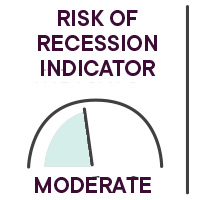Key rate hikes in sight
What moved the markets in January:
- The first month of the year was difficult, both for bond yields and for equity markets, which experienced very high volatility.
Focus on the past month

Overview of global equity markets*
- The flagship index of the Canadian stock market, the S&P/TSX, fell 0.4%.
- In the United States, the S&P 500 lost 4.8% and the Nasdaq, 8.6%.
- International stock markets also ended the month in negative territory, with the EAFE Index down 4.5%.
- Emerging market equities were off 1.5%, while Chinese stocks declined 2.6%.
* All the percentages in this section are in Canadian dollars. Bloomberg unless otherwise indicated.
Key events

Central banks change course
Central banks have changed their tune. A few months ago, they said a rate increase would occur at the earliest in 2023, but in January 2022, they began to plan the first rate hikes for March.
In addition to raising rates, central banks are signaling that they will begin to shrink their balance sheets, suggesting that they will let some bonds mature without making new purchases. This sudden change in tone is largely due to an upsurge in inflation, which is more prevalent and more persistent than expected.
The labour market continues to show positive results and the unemployment rate is no longer at a level that would require an expansionary monetary policy.
Impact of inflation on the markets
A faster-than-expected rise in key rates has an effect on stock valuations, particularly those of companies with low or non-existent profits. In fact, we have seen a sharp decline in technology issues that have no earnings or that are very expensive, the ARK Innovation ETF being a prime example.
Focus on growth
Still strong economic growth, coupled with reduced pandemic constraints and full employment, favours more cyclical stocks.
- A resumption of tourism and travel means increased fuel consumption, and underinvestment in oil exploration is contributing to higher gasoline prices.
- Rising interest rates favour the banking sector, while investments in renewable energy and infrastructure help the basic materials and industrial sectors.
In this context, central banks must continue to support economic growth, while limiting inflation.
We believe that inflation will decline over the next few months. A resolution of global supply chain issues and weaker demand for goods, with a concomitant increase in demand for services, should help.
China in catch-up mode
The Chinese government is trying to manage its real estate crisis and the resulting economic slowdown, while limiting the risk of contagion to other sectors of the economy.
Weaker global demand for goods heralds a headwind for the Chinese economy. With consumer spending in the services sector constrained by the pandemic, demand for goods has increased significantly, well beyond its historical growth trend. With the resumption of activity in many economic sectors, demand for goods should be below the historical trend in 2022.
Employment still robust
Job creation in the United States was stronger than expected, but a change in methodology largely explains this favourable result, as does the revised number for the previous month. The labour force participation rate increased, which is positive, with more people now in in the labour market.
In Canada, closures due to the Omicron variant have had a negative impact on job creation, but the labour shortage still persists.
Results – Canadian bonds
Government of Canada bonds across maturities posted a negative return of 1.6% for the month. (Source: Canaccord Genuity)
Performance of our funds
View the returns

Our strategic monitoring
Main risks
Here are some risks that we are closely monitoring in the current environment.
- The possibility of an episode of stagflation, i.e. anemic economic growth and high inflation, persists. This situation is negative for the stock markets.
- An overly restrictive monetary policy could cause a major economic slowdown or even a recession.
- A Russian invasion of Ukraine is a geopolitical risk that could negatively impact the markets, and particularly the price of natural gas in Europe, which could lead to an economic slowdown in that region.
Fundamental indicators
Some economic indicators we continued to follow in January.
Benchmark rates in Canada, Europe and the United States ![]()
The central bank shift to more restrictive monetary policies is negative for the value of financial assets.
Global Purchasing Managers’ Index ![]()
The index remains above 50, which indicates an economic expansion. China’s number is close to contraction level.
Personal savings ![]()
Savings rates in Canada and the United States are still above historical averages. The level of household debt is stable in Canada, and falling in the United States.
Inflation rate ![]()
The inflation rate is well above central banks’ targets, forcing them to raise their policy rates.
 |
 |
| François Landry, CFA Vice-President and Chief Investment Officer |
Yann Furic, B.B.A., M.Sc., CFA Senior Manager, Asset Allocation and Alternative Strategies |
Sources: Bloomberg
The opinions expressed here and on the next page do not necessarily represent the views of Professionals’ Financial. The information contained herein has been obtained from sources deemed reliable, but we do not guarantee the accuracy of this information, and it may be incomplete. The opinions expressed are based upon our analysis and interpretation of this information and are not to be construed as a recommendation. Please consult your Wealth Management Advisor.









